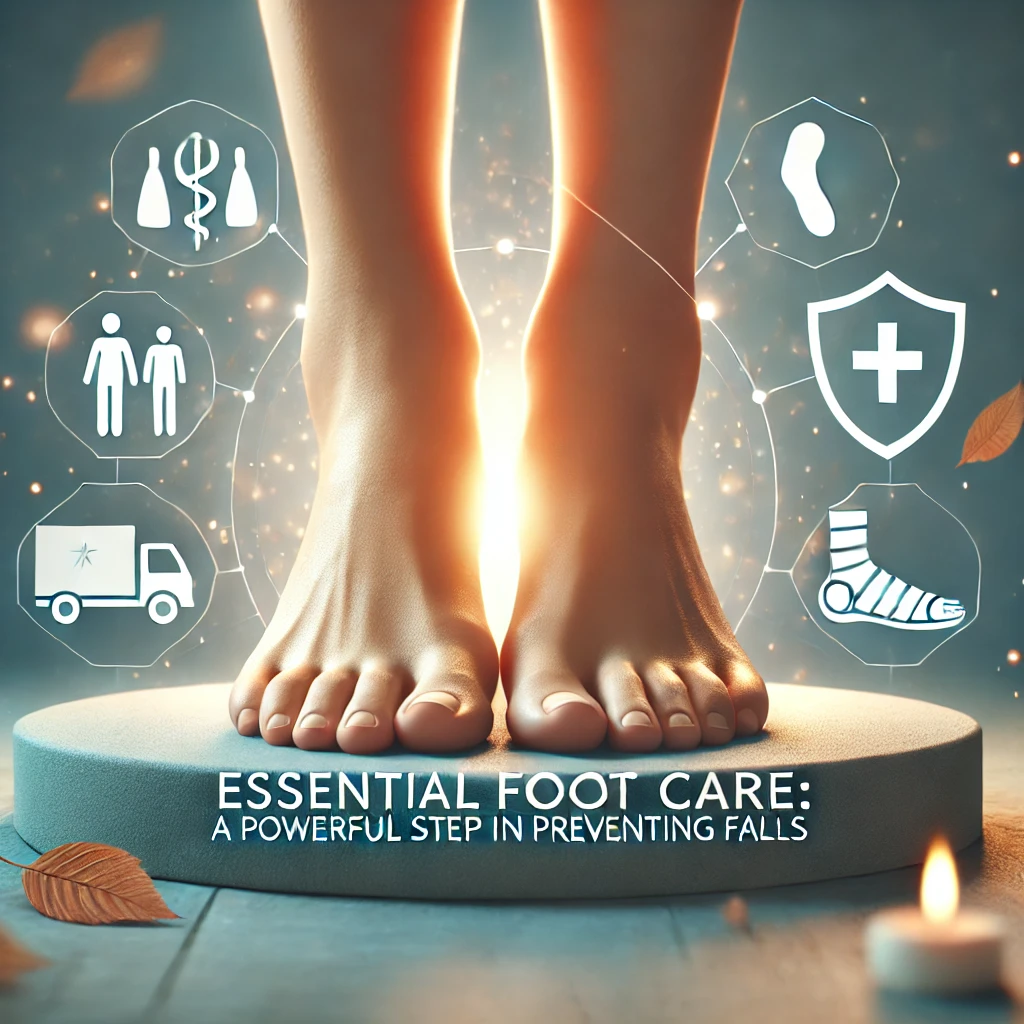Unlock the secrets to preventing and naturally caring for foot ulcers with our empowering guide. Dive into expert insights and holistic strategies designed to enhance your understanding, prevent future occurrences, and embrace a path to recovery.
What Are Foot Ulcers?
Foot ulcers are open sores or wounds that typically develop on the bottom of the foot. They can vary in depth and severity and, without proper care, can lead to significant health risks.

Foot ulcers, a common yet often overlooked health issue, can significantly impact one’s quality of life, leading to discomfort and, in severe cases, more serious health complications. This guide aims to shed light on the causes, prevention, and natural remedies for foot ulcers, offering a beacon of hope and healing for those affected.
Table of Contents
The Culprits Behind Foot Ulcers
Diabetes: High blood sugar levels can lead to nerve damage and poor circulation, making it hard for foot ulcers to heal.
Pressure: Constant pressure or friction on one part of the foot can cause ulcers.
Vascular Disease: Conditions that affect blood flow to the feet can hinder the healing of wounds.
Neuropathy: Loss of sensation in the feet can prevent early detection of cuts or blisters, leading to ulcers.
Infection: Bacteria entering through small wounds can infect ulcers, causing inflammation and complicating healing, potentially leading to severe outcomes like gangrene.
Poor Footwear: Ill-fitting shoes may cause friction and pressure, leading to ulcers. Properly fitting footwear is essential for prevention.
Smoking: It impairs circulation, reducing the body’s ability to heal, thus increasing the risk of ulcers.
Obesity: Extra weight puts additional pressure on the feet, making skin breakdown and ulcer formation more likely.
Alcohol Consumption: Excessive drinking can cause neuropathy, reducing foot sensation and the ability to notice injuries, which can lead to ulcers.
Immobility: Limited movement, especially in bedridden individuals or wheelchair users, can cause pressure ulcers due to constant weight on certain foot areas.
Poor Hygiene and Foot Care: Neglecting regular foot care, such as cleaning and moisturizing, can increase the risk of skin breakdown and infection.
Age: Aging skin, decreased blood flow, and the prevalence of conditions like diabetes increase the risk of foot ulcers in the elderly.
Comprehensive Guide to Preventing and Caring for Foot Ulcers
Foot ulcers, particularly prevalent among individuals with diabetes or vascular diseases, can lead to severe complications if not properly managed. Preventative measures and effective natural remedies are essential for maintaining foot health and facilitating the healing process of foot ulcers. Here’s a detailed look at how to prevent foot ulcers and employ natural remedies for their care.
Preventing Foot Ulcers
Proper Footwear
Selection Tips
Choose well-fitting, comfortable shoes that offer good support and do not pinch or rub. Breathable materials and a cushioned sole are preferable. Avoid high heels and shoes with pointed toes that can cause undue pressure.

Custom Solutions
For those with existing foot problems, custom orthotic devices may be recommended to provide additional support and distribute pressure evenly across the foot.
Daily Foot Inspections
How to Do It
Check your feet every day for signs of blisters, cuts, cracks, sores, redness, tenderness, or swelling. Pay special attention to the areas between the toes and the bottom of the feet. Use a handheld mirror or ask for assistance if you’re unable to see all parts of your feet.

Why It’s Important
Early identification of potential problems allows for prompt treatment, reducing the risk of ulcers.
Manage Your Health
Diabetes and Vascular Disease Management
Regular monitoring and control of your condition can significantly reduce the risk of foot ulcers. Follow your healthcare provider’s advice regarding medication, diet, and exercise.
Regular Check-ups
Schedule periodic foot examinations with a healthcare professional, especially if you have an increased risk of foot ulcers.
Natural Remedies for Foot Ulcer Care

Honey Dressings
Application Process: After cleaning the ulcer and surrounding area with mild soap and water, apply a thin layer of medical-grade honey to the ulcer. Cover with a sterile bandage or gauze. Change the dressing daily, or as directed by a healthcare professional.
Benefits: Honey’s natural antibacterial and osmotic properties can help reduce infection risk and promote healing by drawing out excess fluid from the ulcer.
Aloe Vera
How to Use: Apply a layer of fresh aloe vera gel directly onto the ulcer or on a clean dressing that is then placed on the ulcer. Ensure the area is clean before application to prevent infection.
Healing Effects: Aloe vera’s soothing and anti-inflammatory properties can help reduce pain and swelling, creating an optimal healing environment.


Turmeric Paste
Preparation and Application: Mix turmeric powder with a small amount of water to create a paste. Apply this paste directly to the ulcer and cover with a clean dressing. The paste should be changed daily.
Why It Works: Turmeric contains curcumin, known for its potent anti-inflammatory and antioxidant properties, which can aid in reducing inflammation and promoting wound healing.
Additional Care Tips

Moisture Control: Keep the area around the ulcer clean and dry to prevent infection. If the ulcer is excessively dry, consult a healthcare professional for suitable moisturizing options.
Pressure Relief: Use specialized foot care products, such as cushioned insoles or diabetic shoes, to relieve pressure on the ulcerated area.
Nutrition: A balanced diet rich in vitamins and minerals supports the body’s healing processes. Foods high in protein, vitamin C, and zinc are particularly beneficial for wound healing.
Lifestyle Adjustments for Healing and Prevention of Foot Ulcers
Managing foot ulcers involves more than just direct wound care; it requires comprehensive lifestyle adjustments. These changes not only aid in the healing of existing ulcers but also play a crucial role in preventing future occurrences. Here’s a detailed exploration of lifestyle adjustments beneficial for individuals dealing with foot ulcers.
Balanced Diet
What to Eat:
- Vitamin C-Rich Foods: Citrus fruits, strawberries, bell peppers, and broccoli can boost collagen production, essential for wound healing.
- Zinc-Enriched Foods: Incorporate beef, pumpkin seeds, lentils, and chickpeas into your diet to support immune function and wound healing.
- Protein: Adequate protein intake is vital for repair; lean meats, fish, poultry, tofu, and beans are excellent sources.
- Omega-3 Fatty Acids: Found in fish like salmon and mackerel, as well as flaxseeds and walnuts, omega-3s can reduce inflammation.
How It Helps:
A balanced diet enhances the body’s ability to heal by providing essential nutrients that support skin regeneration, immune defense, and overall health.
Quit Smoking
Steps to Quit:
- Set a Quit Date: Choose a date close enough to be urgent but allowing enough time to prepare.
- Identify Triggers: Recognize situations that make you want to smoke and plan alternatives.
- Seek Support: Consider support groups, counseling, or therapies such as nicotine replacement therapy (NRT) or prescription medications.
- Stay Active: Physical activity can reduce nicotine cravings and withdrawal symptoms.
Impact on Healing:
Smoking constricts blood vessels, impairing blood flow to the feet, crucial for delivering nutrients and oxygen for ulcer healing. Quitting smoking can significantly improve circulation and the body’s overall healing capacity.
Stress Management
Effective Techniques:
- Yoga and Meditation: These practices can reduce stress hormones in the body, promoting a state of relaxation and enhancing the healing process.
- Gentle Exercise: Activities like walking or swimming can increase blood flow and reduce stress without putting excessive pressure on the feet.
- Deep Breathing Exercises: Simple deep breathing techniques can quickly alleviate stress, beneficial for both mental and physical health.
- Time Management: Prioritizing tasks and taking breaks can prevent stress buildup.
Why It Matters:
Stress can negatively impact the body’s immune response and slow the healing process. Managing stress through these techniques can create a more conducive environment for healing and overall well-being.
Implementing the Changes
Monitoring Progress
Keep a Food Diary: Track your intake of healing nutrients.
Celebrate Milestones: Acknowledge successes in your journey to quit smoking.
Reflect on Stress Levels: Regularly assess your stress and the effectiveness of your management strategies.
Consultation with Professionals:
Dietitian: For personalized dietary advice to support healing.
Smoking Cessation Specialist: For tailored strategies and support in quitting smoking.
Therapist or Counselor: For coping strategies and support in managing stress.
Recognizing the Need for Professional Help and Navigating the Path to Recovery
Healing foot ulcers is a process that demands diligence, appropriate care, and a commitment to overall health improvement. While natural remedies can play a supportive role in this healing journey, recognizing when to seek professional medical assistance is paramount for effective treatment and recovery.
When to Consult a Healthcare Professional
Immediate consultation with a healthcare provider is essential under the following circumstances:
| Deep Ulcers |
| If the ulcer is profound enough to expose bone or tendon, it indicates severe tissue damage requiring specialized medical intervention. |
| Signs of Infection |
| Symptoms such as redness, warmth around the ulcer, or the presence of pus are clear indicators of infection. Infections not only complicate the healing process but can also lead to more severe systemic issues if left untreated. |
| Lack of Improvement |
| If there’s no noticeable improvement in the ulcer’s condition after a week of diligent home care, professional evaluation is necessary to reassess treatment strategies and prevent further complications. |
The Healing Journey
The path to recovering from a foot ulcer involves more than just addressing the wound itself; it encompasses a holistic approach to health and well-being. By understanding the underlying causes of foot ulcers, individuals can take proactive steps towards prevention, such as adopting a balanced diet, maintaining proper foot hygiene, wearing appropriate footwear, and managing health conditions like diabetes or vascular disease that increase ulcer risk.
Incorporating natural remedies under the guidance of healthcare professionals can support the healing process, offering anti-inflammatory and antibacterial benefits that complement medical treatments. However, these should not replace conventional care, especially in cases of severe ulcers or signs of infection.
FAQ Section
Q: What exactly are foot ulcers?
A: Foot ulcers are open sores or wounds that typically occur on the foot’s surface, often as a result of underlying conditions such as diabetes or poor circulation. They can vary in severity and depth, requiring careful management to prevent infection and further complications.
Q: Who is at risk for developing foot ulcers?
A: Individuals with diabetes, peripheral neuropathy, poor circulation, or those who wear ill-fitting shoes are at a higher risk. Obesity and smoking also increase the likelihood of ulcer formation due to the added pressure on the feet and reduced blood flow.
Q: Can foot ulcers be prevented?
A: Yes, through diligent daily foot inspections, wearing properly fitting footwear, managing underlying health conditions, and adopting a healthy lifestyle, the risk of foot ulcers can be significantly reduced.
Q: Are there natural remedies for foot ulcer care?
A: Natural remedies such as honey dressings, aloe vera, and turmeric paste can support the healing process by offering antibacterial and anti-inflammatory benefits. However, they should complement, not replace, professional medical treatment.
Conclusion
Foot ulcers, while challenging, can be managed effectively with the right approach. This guide serves as a resource to empower you with knowledge and practical strategies for prevention and care. Remember, early detection and treatment are key to a successful recovery. Embrace these insights and holistic remedies as part of your journey towards optimal foot health. Should you face any signs of foot ulcers, consult a healthcare professional promptly to ensure the best possible outcome. Together, let’s step forward on the path to healing and prevention, ensuring your feet remain healthy and strong for years to come.











No matter if some one searches for his vital thing,
therefore he/she desires to be available that in detail, thus
that thing is maintained over here.
This blog was… how do you say it? Relevant!! Finally I have found
something that helped me. Thanks!
I simply could not depart your site prior to suggesting that I extremely
enjoyed the usual information a person supply to your guests?
Is gonna be back steadily in order to investigate cross-check new
posts
It’s actually a cool and helpful piece of info. I am satisfied
that you just shared this helpful info with us. Please keep us
informed like this. Thanks for sharing.
I love it when people come together and share opinions, great blog, keep it up.